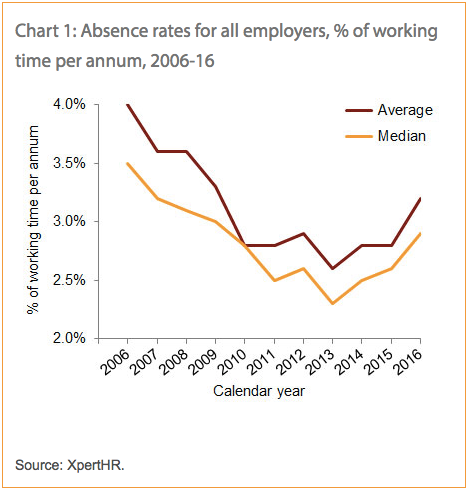XpertHR absence survey 2017 shows rising absence levels
For the first time since 2009, XpertHR annual absence survey 2017 shows an average absence level above 3%. Among the 588 survey respondents that provided data on absence rates for 2016, the national average stood at 3.2% of working time, equivalent to 7.4 days per employee. To help compare with the preferred metric used in CIPD annual absence survey, this year’s median figure in XpertHR data was 6.6 absence days per employee. In 2016 CIPD reported a median level of 6.3 days per employee.
This chart by XpertHR shows the 11-year trend in absence levels:
Year-on-year comparison shows a rise in absence
XpertHR matched 36 employers to responses submitted last year. These year-on-year comparisons also showed a rising trend: the median absence rate stood at 2.9% of working time in 2015, and at 3.4% for 2016. The average rates for both years stood at 2.9% and 3.1% respectively.
If the comparison had shown a trend contrary to the overall findings, it could have suggested that the rise in absence is driven by changes in respondents or by new organisations submitting responses. The fact that the returning respondents also reported an increase in time lost to absence, suggests this trend is indicative of changes in UK business.
Only greater focus on cost can achieve effective absence management
Cost of absence is as overlooked by employers as always. XpertHR explain that “these [cost] figures are unlikely to reflect the true cost of sickness absence to organisations. Just 10 (8%) of those that provided figures measure costs arising from reduced performance or service, or missed business opportunities. Fewer than one in five (19%) measure the fees or wages of temporary staff providing cover for absent individuals. We have seen little or no change in the 11 years that we have been asking organisations how they measure the cost of sickness absence, with many organisations focusing only on the salaries of individuals on sick leave. The cost is as crude today as it was in 2006. Until organisations get the cost of sickness absence accurate, it is going to be difficult to persuade line managers and senior managers to engage with effectively managing employees’ absence.”
Private sector pays more for absence than public sector
Having said all of this, the interesting finding in this year’s absence survey was that private sector organisations reported a higher cost of absence than public sector. For the first time since XpertHR started monitoring sickness absence costs, the median cost of absence was higher among private-sector organisations – at £765 per employee, compared with £746 for public-sector employers.
Start recording your absence and cost data accurately today with Engage!

